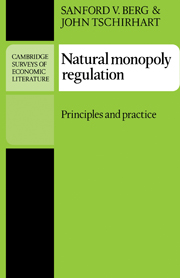Book contents
- Frontmatter
- Contents
- Preface
- 1 Introduction to regulatory economics
- Part I Optimal pricing and investment for natural monopolies
- Part II Natural monopoly regulation in practice
- 8 Regulation in practice: Why and how are firms regulated?
- 9 Models of regulatory constraints
- 10 Technological change under regulation
- 11 Partial regulation, deregulation, and diversification
- 12 Alternatives to traditional regulation
- References
- Author index
- Subject index
10 - Technological change under regulation
Published online by Cambridge University Press: 06 November 2009
- Frontmatter
- Contents
- Preface
- 1 Introduction to regulatory economics
- Part I Optimal pricing and investment for natural monopolies
- Part II Natural monopoly regulation in practice
- 8 Regulation in practice: Why and how are firms regulated?
- 9 Models of regulatory constraints
- 10 Technological change under regulation
- 11 Partial regulation, deregulation, and diversification
- 12 Alternatives to traditional regulation
- References
- Author index
- Subject index
Summary
The resource-allocation issues considered so far have taken the technology as given; so the regulated natural monopoly has had no choice in the nature of its production function. However, some of the most important policy issues of the day involve incentives for innovative activity by natural monopolies and how regulation affects the pace and pattern of technological change. Although there are no simple answers in such matters, a number of models have been developed that offer insights into how the incentives facing the regulated firm help determine the introduction of new products, the tendency to improve the quality of various production inputs, and the rate of cost reduction.
First, we need to characterize technological change and identify the firm's decision variables and the instruments available to regulators. Because the sources and impacts of innovation have been surveyed by Kamien and Schwartz (1982), Section 10.1 provides only a brief review of how the characteristics of new knowledge complicate the analysis of its production and application. Then we examine the impact of competitive pressures on the incentive to engage in research and development (R&D). In addition, because cooperative ventures are significant suppliers of innovations in electricity and telecommunications, we consider how regulatory policies affect these joint R&D activities. Section 10.2 presents a model of cost-reducing R&D programs. The model allows us to examine the interrelationships among technological opportunities, regulatory lag, and R&D activity.
Specifying the precise nature of the technological changes underlying cost reductions allows additional inferences regarding the potential impacts of regulation.
- Type
- Chapter
- Information
- Natural Monopoly RegulationPrinciples and Practice, pp. 385 - 427Publisher: Cambridge University PressPrint publication year: 1989

